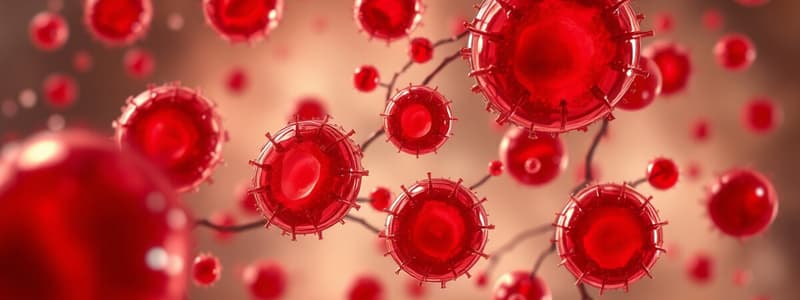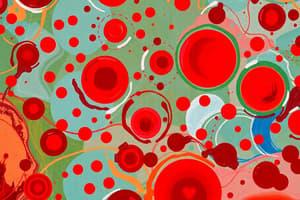Podcast
Questions and Answers
A patient's blood sample appears to be a dull, brick-red color. Which of the following is the most likely explanation for this observation?
A patient's blood sample appears to be a dull, brick-red color. Which of the following is the most likely explanation for this observation?
- The patient is experiencing an acute allergic reaction.
- The blood is carrying a lower than normal amount of oxygen. (correct)
- The patient has an abnormally high concentration of leukocytes.
- The blood sample is hemolyzed, releasing hemoglobin into the plasma.
If a patient has a blood volume of 5 liters, approximately how much of their blood is typically composed of plasma?
If a patient has a blood volume of 5 liters, approximately how much of their blood is typically composed of plasma?
- 4.5 Liters
- 2.25 Liters
- 3.75 Liters (correct)
- 2.75 Liters
A researcher is studying a blood sample and observes a high number of cells actively releasing histamine. Which type of leukocyte are they most likely observing?
A researcher is studying a blood sample and observes a high number of cells actively releasing histamine. Which type of leukocyte are they most likely observing?
- Basophils (correct)
- Eosinophils
- Neutrophils
- Monocytes
Following a minor laceration, which formed element would be the MOST critical in initiating the process of hemostasis?
Following a minor laceration, which formed element would be the MOST critical in initiating the process of hemostasis?
Which of the following best describes the primary role of monocytes within the bloodstream?
Which of the following best describes the primary role of monocytes within the bloodstream?
Flashcards
Blood
Blood
Connective tissue with cells in a matrix; includes plasma and formed elements.
Plasma
Plasma
Liquid part of blood, mostly water, carrying nutrients, gases, hormones, and wastes.
Erythrocytes (RBCs)
Erythrocytes (RBCs)
Red blood cells; sacs of hemoglobin that transport oxygen and carbon dioxide.
Leukocytes (WBCs)
Leukocytes (WBCs)
Signup and view all the flashcards
Platelets
Platelets
Signup and view all the flashcards
Study Notes
-
- Blood color exhibits a spectrum that ranges from a vibrant bright red, indicating high oxygen saturation, to a dull brick red when the oxygen content is low. This color variation is essential for indicating the physiological state of the blood, and it serves as a visual cue regarding the oxygen transport capacity of the blood.
- Oxygen-rich blood, primarily found in the arteries, is bright red due to the binding of oxygen molecules to the iron atoms within hemoglobin, the protein responsible for oxygen transport. This bright red blood provides critical information about the efficiency of the respiratory and circulatory systems in delivering essential oxygen to body tissues.
- The average blood volume in adult males is approximately 5-6 liters, which accounts for about 7-8% of their total body weight. This volume is crucial for maintaining homeostasis, transporting nutrients, and responding to injuries. The exact amount can vary based on factors such as body size, physical activity level, and overall health.
- In females, the blood volume is generally a bit lower, ranging from roughly 4-5 liters. Differences in blood volume between males and females can be attributed to differences in body composition and hormonal influences, which also play a significant role in the physiological functions of blood.
- Blood is classified as a specialized type of connective tissue because it comprises cells suspended within a fluid matrix. This classification highlights its vital role in connecting different body systems through the circulation of nutrients, waste removal, and immune responses.
- The nonliving fluid matrix of blood, known as plasma, is a pale yellow liquid that carries cells and various substances throughout the body. Plasma plays a significant role in maintaining blood pressure and regulating body temperature, serving as a medium for transporting nutrients and facilitating biochemical reactions within the body.
- Plasma contains over 100 dissolved substances, encompassing various categories including nutrients, gases (such as oxygen and carbon dioxide), hormones, metabolic wastes, proteins, and electrolytes. These components are essential for various physiological functions, including immune responses, fluid balance, and nutrient transport. Notably, plasma constitutes more than 90% water, underscoring its role as the primary medium for biochemical transport.
- The composition of plasma is not static; it changes dynamically as cells within the body uptake or release substances into the bloodstream. This adaptability allows the body to respond to changing physiological needs and conditions, such as during exercise, fasting, or illness.
- Typically, formed elements, which comprise cells and cell fragments, constitute about 45% of whole blood volume, while plasma makes up the remaining 55%. This ratio is crucial for the functional efficiency of blood, ensuring optimal transport of respiratory gases and other essential substances.
Elements of Blood
- Within the composition of blood, three main types of cellular elements can be identified: erythrocytes (red blood cells), leukocytes (white blood cells), and platelets (thrombocytes). Each of these elements plays a unique and indispensable role in maintaining bodily functions and responding to health threats.
- Erythrocytes, commonly known as red blood cells (RBCs), represent the most abundant cell type in blood, making up roughly 99% of the formed elements. Their primary function is to transport oxygen from the lungs to tissues and return carbon dioxide from tissues back to the lungs for exhalation. This process is essential for cellular respiration and energy production.
- Erythrocytes are essentially specialized sacs filled with hemoglobin; this protein not only binds oxygen but also facilitates the transport of carbon dioxide and participates in regulating blood pH. The biconcave shape of erythrocytes increases their surface area for gas exchange and allows them to maneuver through the capillaries effectively.
- Leukocytes, or white blood cells (WBCs), form an essential component of the immune system, defending the body against infections, pathogens, and foreign substances. They vary in number, type, and function, and their presence is critical for the body's nonspecific defenses and adaptive immune responses.
- Platelets are small, disc-shaped cell fragments derived from megakaryocytes and play a critical role in hemostasis, the process of blood clotting. When a blood vessel is injured, platelets adhere to the site of damage, aggregate with each other, and release chemical signals that promote further platelet recruitment, ultimately forming a clot that prevents excessive blood loss.
Types of Blood Cells
- Erythrocytes (red blood cells or RBCs) are responsible for the transport of oxygen as well as carbon dioxide between the lungs and various tissues in the body. The proper functioning of erythrocytes is crucial for sustaining cellular metabolism and energy production.
- Leukocytes comprise several different types of white blood cells (WBCs), each serving specialized roles in immune defense. Their varied functions range from direct attack on pathogens to producing antibodies that neutralize foreign invaders.
- Platelets, while not true cells, are vital for sealing small tears in blood vessels. When a vascular injury occurs, platelets quickly activate and aggregate to form a temporary plug, preventing blood loss and initiating the complex process of coagulation that leads to a more stable clot.
Subtypes of Leukocytes
- Granulocytes, a subgroup of leukocytes, phagocytize (engulf and digest) pathogens or debris. They are characterized by the presence of granules in their cytoplasm and are further divided into three types: neutrophils, eosinophils, and basophils, each with distinct immune functions.
- Eosinophils play a specialized role in combating parasitic infections, particularly those caused by multicellular organisms like worms. They are also involved in the body’s response to allergens and asthma, where they can exert inflammatory effects.
- Basophils release histamine and other mediators of inflammation. They are considered to be involved in promoting allergic reactions and are key players in initiating the inflammatory response. Basophils also produce heparin, an anticoagulant that helps prevent blood clotting within healthy vessels.
- Agranulocytes, which include lymphocytes and monocytes, mount an immune response either through direct cell attack or antibody production. This subgroup is crucial for the adaptive immune response, allowing the body to remember and respond to specific antigens more effectively.
- Monocytes, once they migrate into tissues, differentiate into macrophages, which are highly effective phagocytes, engulfing and digesting pathogens, dead cells, and debris. This process is essential for maintaining tissue health and initiating repair following injury or infection.
Studying That Suits You
Use AI to generate personalized quizzes and flashcards to suit your learning preferences.
Related Documents
Description
Blood consists of plasma and formed elements (erythrocytes, leukocytes, and platelets). Plasma, the nonliving fluid matrix, is over 90% water and contains nutrients, gases, hormones, and proteins. Formed elements make up about 45% of whole blood.



